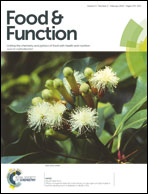A fucose containing polymer-rich fraction from the brown alga Ascophyllum nodosum mediates lifespan increase and thermal-tolerance in Caenorhabditis elegans, by differential effects on gene and protein expression†
Abstract
The extracts of the brown alga, Ascophyllum nodosum, which contains several bioactive compounds, have been shown to impart biotic and abiotic stress tolerance properties when consumed by animals. However, the physiological, biochemical and molecular mechanism underlying such effects remain elusive. We investigated the effect of A. nodosum fucose-containing polymer (FCP) on tolerance to thermally induced stress using the invertebrate animal model, Caenorhabditis elegans. FCP at a concentration of 150 μg mL−1 significantly improved the life span and tolerance against thermally induced stress in C. elegans. The treatment increased the C. elegans survival by approximately 24%, when the animals were under severe thermally induced stress (i.e. 35 °C) and 27% under mild stress (i.e. 30 °C) conditions. The FCP induced differential expression of genes and proteins is associated with stress response pathways. Under thermal stress, FCP treatment significantly altered the expression of 65 proteins (54 up-regulated & 11 down-regulated). Putative functional analysis of FCP-induced differential proteins signified an association of altered proteins in stress-related molecular and biochemical pathways of the model worm.


 Please wait while we load your content...
Please wait while we load your content...